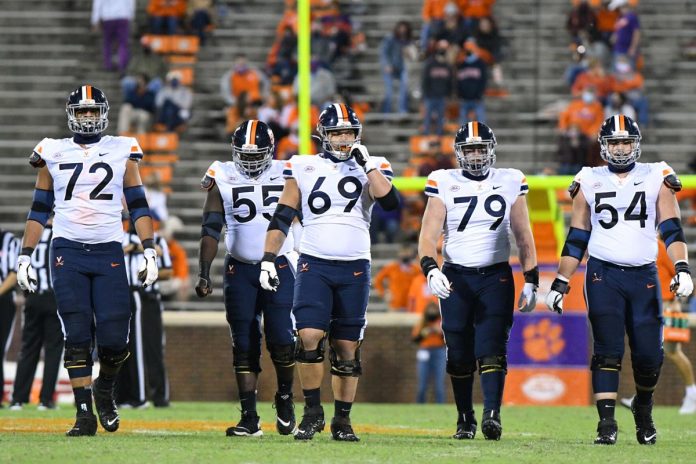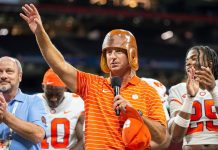After graduating 1,000 yard rusher Jordan Ellis in 2018, Virginia’s offense has been almost completely in the hands of the quarterback. Bryce Perkins led the UVA offense in both passing and rushing the following year, and Brennan Armstrong repeated the trend in 2020.
While their overall attack was certainly efficient in both of those seasons, most would agree that a stronger running game is necessary for more offensive consistency.
More to be Desired
In simple logic, there are two major components to a successful rushing attack: the ball-carrier and the blockers in front of him. And the UVA offensive line has certainly done their part.
Through film study, Football Outsiders determined a formula for the proportion of rushing yards an OLine is responsible for on a given carry.
Here are the line yards per carry FBS rankings in 2020:
5. UVA
16. UNC
17. FSU
31. VT
51. Clemson
66. GT
74. Wake
(cont)— ACC Content (@ACContent__) June 17, 2021
Furthermore, the Hoos were ranked third in the ACC in this statistic in 2019.
So what’s the problem specifically? That could be explained by looking deeper into the statistic.
As described on the Football Outsiders website, line yards are rewarded for the following scenarios:
- Lost yardage is multiplied by 125%
- Each yard for a 0-3 yard rush is credited to the line
- For yards 4-8 on a rush, the line gets 50% of the credit
- Each additional yard is credited to the ball carrier
So if the Virginia line is creating space at the first and second levels yet lead ball-carrier Wayne Taulapapa returns with a mere 4.5 yards per carry, something is missing from the equation.
The most logical explanation is that last bullet from above — there is a lack of breakaway speed after the first 4-8 yards are gained.
Looking Forward
The good news about 2021 is that UVA has a plethora of options at the tailback position. Offensive coordinator Robert Anae has expressed his philosophy in the past that the backfield should be led by an all-purpose player. However, a running back by committee may be the best option.
With the departure of Shane Simpson, Ronnie Walker is my personal answer. Walker played very few snaps last year, due to a combination of eligibility issues and health concerns. Yet, he should be ready to take on a major role next season, if the staff chooses.
Indiana-transfer RB Ronnie Walker commits to UVA!
The Hopewell, VA native adds a much needed speed element to the Virginia backfield but is also very good pass catcher.
Walker joins the Hoos with two years of eligibility.
Watch him run for a 30-yard TD against Penn State: pic.twitter.com/CjS34FD1VE
— ACC Content (@ACContent__) April 17, 2020
Walker can also produce in the receiving game, which can certainly create a more dynamic offense.
I also can’t possibly discuss breakaway speed without mentioning all-purpose offensive weapon Keytaon Thompson. He has shown plenty of elusiveness with the ball. Similar to last season, Thompson is expected to line up in various spots in the formation, including in the backfield alongside Armstrong.
Another intriguing option is true freshman back Aamad Foston. His open field ability is not quite to the level of Walker’s, but he offers valuable traits, nonetheless. Mike Hollins should be in the mix as well.
The Bottom Line
Just 17% of Taulapapa’s yards in 2020 were breakaway yards (yards on carries of 15 or more). That was near the bottom of the Power Five. But keep in mind that short yardage situations are also vital, and he thrives in that respect.
Led primarily by Taulapapa, Virginia ball carriers were 15th in the FBS in opportunity rate — the percentage of carries that gain at least four yards, when available. Additionally, they were in the top third in the ACC in power success rate — converting on third or fourth and short.
When the offense needs just a few yards, Taulapapa is the go-to guy. But from an overall efficiency standpoint, there are other backs on the roster that fit the lead role better.






